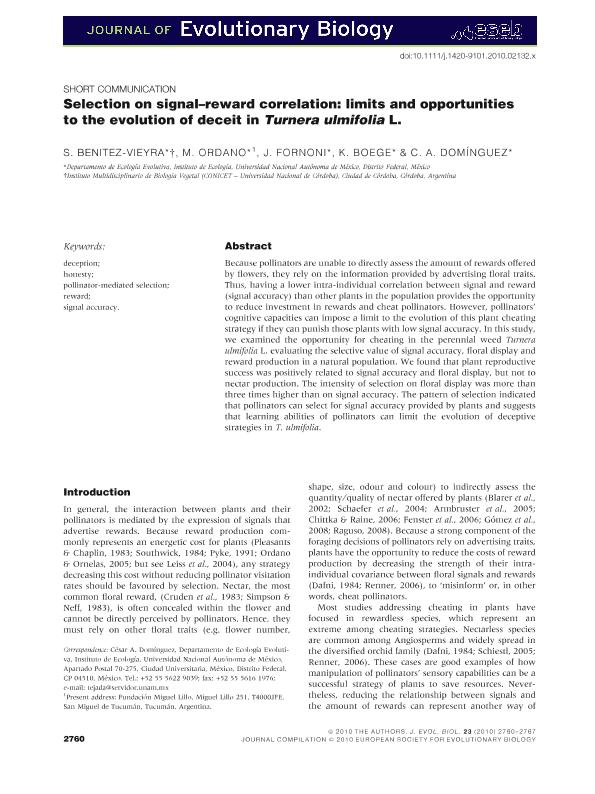Mostrar el registro sencillo del ítem
dc.contributor.author
Benitez-Vieyra, Santiago Miguel

dc.contributor.author
Ordano, Mariano Andrés

dc.contributor.author
Fornoni, Juan
dc.contributor.author
Boege, K.
dc.contributor.author
Domínguez, C. A.
dc.date.available
2017-04-19T14:20:46Z
dc.date.issued
2010-12
dc.identifier.citation
Benitez-Vieyra, Santiago Miguel; Ordano, Mariano Andrés; Fornoni, Juan; Boege, K.; Domínguez, C. A.; Selection on signal-reward correlation: limits and opportunities to the evolution of deceit in Turnera ulmifolia L.; Wiley; Journal Of Evolutionary Biology; 23; 12; 12-2010; 2760-2767
dc.identifier.issn
1010-061X
dc.identifier.uri
http://hdl.handle.net/11336/15439
dc.description.abstract
Because pollinators are unable to directly assess the amount of rewards offered by flowers, they rely on the information provided by advertising floral traits. Thus, having a lower intra-individual correlation between signal and reward (signal accuracy) than other plants in the population provides the opportunity to reduce investment in rewards and cheat pollinators. However, pollinators? cognitive capacities can impose a limit to the evolution of this plant cheating strategy if they can punish those plants with low signal accuracy. In this study, we examined the opportunity for cheating in the perennial weed Turnera ulmifolia L. evaluating the selective value of signal accuracy, floral display and reward production in a natural population. We found that plant reproductive success was positively related to signal accuracy and floral display, but not to nectar production. The intensity of selection on floral display was more than three times higher than on signal accuracy. The pattern of selection indicated that pollinators can select for signal accuracy provided by plants and suggests that learning abilities of pollinators can limit the evolution of deceptive strategies in T. ulmifolia.
dc.format
application/pdf
dc.language.iso
eng
dc.publisher
Wiley

dc.rights
info:eu-repo/semantics/openAccess
dc.rights.uri
https://creativecommons.org/licenses/by-nc-sa/2.5/ar/
dc.subject
Deception
dc.subject
Honesty
dc.subject
Pollinator-Mediated Selection
dc.subject
Plant-Animal Interaction
dc.subject.classification
Biología

dc.subject.classification
Ciencias Biológicas

dc.subject.classification
CIENCIAS NATURALES Y EXACTAS

dc.title
Selection on signal-reward correlation: limits and opportunities to the evolution of deceit in Turnera ulmifolia L.
dc.type
info:eu-repo/semantics/article
dc.type
info:ar-repo/semantics/artículo
dc.type
info:eu-repo/semantics/publishedVersion
dc.date.updated
2017-04-12T17:59:12Z
dc.identifier.eissn
1420-9101
dc.journal.volume
23
dc.journal.number
12
dc.journal.pagination
2760-2767
dc.journal.pais
Reino Unido

dc.journal.ciudad
Malden
dc.description.fil
Fil: Benitez-Vieyra, Santiago Miguel. Consejo Nacional de Investigaciones Científicas y Técnicas. Centro Científico Tecnológico Córdoba. Instituto Multidisciplinario de Biología Vegetal (p); Argentina. Universidad Nacional Autonoma de Mexico. Departamento de Ecologia Evolutiva. Instituto de Ecologia; México. Universidad Nacional de Córdoba; Argentina
dc.description.fil
Fil: Ordano, Mariano Andrés. Universidad Nacional Autonoma de Mexico. Departamento de Ecologia Evolutiva. Instituto de Ecologia; México
dc.description.fil
Fil: Fornoni, Juan. Universidad Nacional Autonoma de Mexico. Departamento de Ecologia Evolutiva. Instituto de Ecologia; México
dc.description.fil
Fil: Boege, K.. Universidad Nacional Autonoma de Mexico. Departamento de Ecologia Evolutiva. Instituto de Ecologia; México
dc.description.fil
Fil: Domínguez, C. A.. Universidad Nacional Autonoma de Mexico. Departamento de Ecologia Evolutiva. Instituto de Ecologia; México
dc.journal.title
Journal Of Evolutionary Biology

dc.relation.alternativeid
info:eu-repo/semantics/altIdentifier/url/http://onlinelibrary.wiley.com/doi/10.1111/j.1420-9101.2010.02132.x/abstract
dc.relation.alternativeid
info:eu-repo/semantics/altIdentifier/doi/http://dx.doi.org/10.1111/j.1420-9101.2010.02132.x
Archivos asociados
